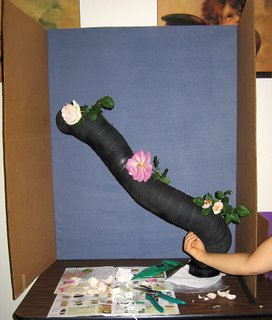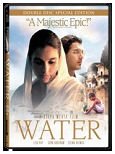Film The Notorious Bettie Page (Mary Harron, 2005)
The film featured good acting by Gretchen Mol who played the lead role. But it was a missable film, probably not worth the money to see on the large screen. I'd give it 5 stars out of 10.
I'm hoping to capture in this web-based journal many of the cultural events that I enjoy.
 The roses are looking okay, though (it always works this way!) I would have had many more to show if the competition were held last weekend. We had very warm weather (it hit 90°F !) but while it was a little cooler, I risked the 40% chance of thundershowers and sprayed my roses for that last extra boost of disease prevention and foliar fertilization (I used all-season oil, copper, baking soda, and kelp). It ended up raining some hours later in the early evening - which was okay, as we do need the water.
The roses are looking okay, though (it always works this way!) I would have had many more to show if the competition were held last weekend. We had very warm weather (it hit 90°F !) but while it was a little cooler, I risked the 40% chance of thundershowers and sprayed my roses for that last extra boost of disease prevention and foliar fertilization (I used all-season oil, copper, baking soda, and kelp). It ended up raining some hours later in the early evening - which was okay, as we do need the water. black twist tie. I had earlier in the day painted two reservoirs black, and we put wet oasis foam in both. A spray of Gourmet Popcorn fit into the slightly leaning "skyscraper" and the reservoir didn't have to be hot glued in place - it fits in nicely and is self-supporting! And the single (here a single and a bud) rose at the base of course is easy. So this arrangement is quite easy to put together and cost only 39¢ (or was it 59¢) for a sheet of plastic, not counting the fabric I already had - and will take literally a few moments to place at the show and should take no more than 15 minutes including choosing the flowers and getting them in place. I think it is elegant, simple, and has the potential to garner a 1st or 2nd place - provided I have good specimens of Gourmet Popcorn (I think I will).
black twist tie. I had earlier in the day painted two reservoirs black, and we put wet oasis foam in both. A spray of Gourmet Popcorn fit into the slightly leaning "skyscraper" and the reservoir didn't have to be hot glued in place - it fits in nicely and is self-supporting! And the single (here a single and a bud) rose at the base of course is easy. So this arrangement is quite easy to put together and cost only 39¢ (or was it 59¢) for a sheet of plastic, not counting the fabric I already had - and will take literally a few moments to place at the show and should take no more than 15 minutes including choosing the flowers and getting them in place. I think it is elegant, simple, and has the potential to garner a 1st or 2nd place - provided I have good specimens of Gourmet Popcorn (I think I will). with water and blooms (I used a few English David Austin roses that do shatter easily, as well as an old Melody Parfumee bloom) - and the sculpture held up fine! I didn't take a picture then but here you can see Sangeeta holding one of the vials in place and placing the others so that they stay by themselves. I had painted (but didn't use here in our trial) vials black, and want to hot glue them behind the sculpture so they're not much visible.
with water and blooms (I used a few English David Austin roses that do shatter easily, as well as an old Melody Parfumee bloom) - and the sculpture held up fine! I didn't take a picture then but here you can see Sangeeta holding one of the vials in place and placing the others so that they stay by themselves. I had painted (but didn't use here in our trial) vials black, and want to hot glue them behind the sculpture so they're not much visible. Tonight was the local opening night of the third in Deepa Mehta's element trilogy, Water (Fire and Earth were the first two). What a moving and well-made film! I enjoyed seeing it and hope to post a review soon [May 21: see review below].
Tonight was the local opening night of the third in Deepa Mehta's element trilogy, Water (Fire and Earth were the first two). What a moving and well-made film! I enjoyed seeing it and hope to post a review soon [May 21: see review below].Links of interest:
My review to be published in the June issue of Saathee magazine
Film review by Dilip Barman, ©Dilip Barman, 2006
Film: Water
Director, year: Deepa Mehta, 2005
Length: 117 minutes
Date: May 20, 2006
For publication: Saathee Magazine, June 2006
I saw Deepa Mehta’s long awaited conclusion to her elements trilogy on local opening night, May 19, 2006. This historical fiction is set in 1938 colonial India in ancient Benares, the world’s oldest continually inhabited city. Child marriage was common and often young women or even girls were widowed. Social mores forbade remarriage and family economic circumstances often exiled the widows with money trumping love, respect, or duty.
The film opens with Chuyia (played by an actor credited as Sarala), an 8-year-old child bride, being told that her adult husband has died. She barely remembers the wedding but is taken to the funeral pyre and her hair is shorn. She is soon abandoned in a widow’s ashram to live out her life dressed in white and shunned by society, as if she had done something wrong.
Chuyia of course wants to return home but eventually settles in to the ashram, developing friendships with the other women there, such as 80-year-old Patiraji (Vidula Javalgekar) who still fantasizes about the wedding sweets that she enjoyed as a child before her husband passed away, devout cook Shakuntala (Seema Biswas, who played the title role in the 1994 film Bandit Queen), and especially the beautiful Kalyani (Lisa Ray). Madhumati (Manorama) is the stern matron of the house, giving the “ashram” a Dickensian feel. In fact, it’s not much of an ashram that she runs, but an institution that keeps her plump by assigning some of the others to demeaning “relationships” to bring money in.
However, times were changing, and Gandhi’s non-violent resistance to British rule was only part of his efforts to help all of India’s people and fight repressive social customs like treatment of widows. Raja Ram Mohun Roy had already in the nineteenth century founded the Brahmo Samaj reform movement, helping in theory to allow remarriage of widows and ban sati, the ghastly self-immolation of a widow on her husband’s funeral pyre.
Into the story comes the idealistic Gandhian student , Narayana (John Abraham). After a chance encounter with Chuyia and Kalyani, Narayana maintains contact with Kalyani. She is charmed by him and he helps validate her feelings of self-worth and question a system that so punishes her and other widows. To Madhumati’s disgust, Kalyani does the unthinkable and considers remarrying as Narayana courts her.
The film goes on to dramatize the trajectories of these characters. What kind of life will Chuyia have when her natural inquisitiveness and vibrancy clash with the imposed guilt and segregation she faces from the culture and in the ashram? Where will the taboo love of Kalyani and Narayana go in a society which forbids even touching the shadow of a widow? Will there be an answer to Chuyia’s question about where equivalent homes exist for men who have lost their wives? Will Shakuntala be able to resolve her piety and religious studies with the expectations that society places on her? And how does a short stop of the Mahatma in town and his ongoing social reform efforts affect the status of widows such as Kalyani, Chuyia, Shakuntala, and the others?
Water plays a role throughout the film. Water absolves sins and purifies the dirty. It can flow dynamically and joyously, giving continuity over time and space, or it can stagnate and decay, not keeping up with changing times.We see the Mother Ganges River escorting away the ashes of widows who have died, finally after their austere penance hopefully en route to a promised rewarding afterlife.
In India, the story was controversially seen by some as critical of Hindu culture. Initially, the government approved the script and stood behind the production, but came to ban the film in the interests of public safety after the film set was destroyed. Filming moved to Sri Lanka (my companion noted some coconut trees in at least one scene that was to have been on the Ganges River). My view is that no system or society, regardless of inherent maturity and philosophical beauty, should so ossify as to not be willing to shine flames of truth on itself in reflective consideration.
Film notes, echoed by a cursory review on the web, indicate that India today has about thirty-three million widows, the highest of any country. Though sati has long been outlawed, many widows, especially in rural areas, “still find themselves ritually humiliated, ostracized by their families and leading lives of intense poverty on the outskirts of society, often as beggars or prostitutes”, according to the film’s production notes.
All that said, I wish that Deepa Mehta had given some context to her film. I’m afraid that those not familiar with Hindu culture may see the film and dismiss the entire philosophical tradition as blindingly misogynistic. Clearly there are very significant issues, but there is also arguably a case to be made for ancient India as perhaps the fountainhead for egalitarian feminist thought and action. Ancient Hindu thought extolling the strength and wisdom of, and respect due, women (in fact, all creatures in the ahimsa religions of Hinduism, Buddhism, and Jainism) is reflected in many aspects, including the notion of Bhudevi as Mother Earth and the Vedic notion of feminine Shakti, coming from the Sanskrit “shak”, meaning “to act” or “to be able”, which empowers women as the holders of power.
I have enjoyed all of the films in Deepa Mehta’s trilogy. I hold at the pinnacle of the three Earth, portraying the unusual perspective of Parsis caught in the uproar of the 1947 Partition, and find Water a close second. I also enjoyed Fire, which I feel was misinterpreted as another “taboo” exposition, rather than being seen as stinging social commentary against patriarchy.
I highly recommend Water. The story is (unfortunately) heartbreakingly based on historically true practices that, to some extent, continue, and the film and the issues it raises deserve wide exposure and discussion. It is moving, emotionally strong and thought provoking, and ultimately hopeful. As a photographer, I marveled throughout the film at the powerful visual compositions, stunning lighting, and sheer beauty of Water. The acting is convincing and quite strong, though Lisa Ray’s portrayal of the illiterate Kalyani was perhaps a bit too refined for what might be expected. The traditional classical and semi-classical musical compositions with A.R. Rahman’s touch formed a soothing accompaniment.
If you can, do see Water on the big screen. A DVD is also available which I might recommend for a second viewing.
9 stars out of 10
Note: all pictures are ©2006 by Twentieth Century Fox, and used with their permission.
On March 16th 2003 Rachel Corrie was tragically killed by an Israeli military bulldozer while defending a Palestinian home from illegal demolition in Rafah, Gaza. On Tuesday, May 9 a reading of the play, My Name is Rachel Corrie will be held at the Manbites Dog Theater in Durham. ... The play is currently enjoying a successful run in London, unfortunately an anticipated opening in New York was recently canceled due to political pressure. The presentation will be directed by Jay O'Berski and feature Dana Marks. Jay is very interested in doing a full production and a good audience at the reading will certainly encourage what could be an important theater event as well as a strong statement against censorship.